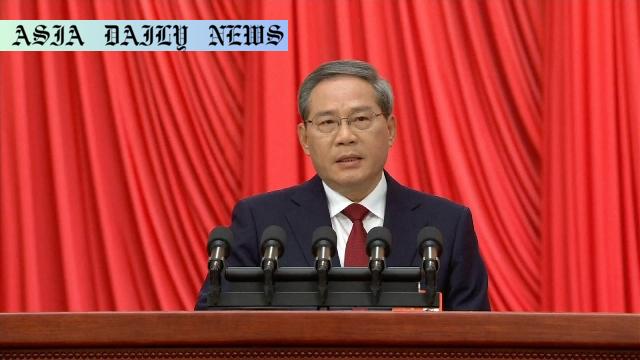GDP Growth, China targets around 5% GDP growth for 2025, maintaining its focus on economic stability amid trade tensions.
- China sets a GDP growth target of around 5% for 2025.
- Focus remains on boosting domestic consumption and trade resilience.
- Defense spending to increase by 7.2% amid regional tensions.

China’s GDP Growth Target: Ambitious Yet Pragmatic
China has officially declared its GDP growth target of around 5% for the year 2025, mirroring its achievement of the same percentage in 2024. The announcement was made during the National People’s Congress, China’s most significant annual political event. Premier Li Qiang emphasized the stability of this goal amidst growing economic and geopolitical uncertainties. This target reflects a commitment to maintaining steady economic progress despite challenges posed by external factors like trade tensions and internal hurdles including recent economic slowdowns.
The Chinese economy has long relied heavily on exports, bolstered by a manufacturing sector that drives global markets. However, the changing dynamics of international trade, exacerbated by escalating trade conflicts with the United States, have forced Beijing to rethink its strategies. Washington’s recent decision to double tariffs on Chinese goods to 20% has prompted immediate countermeasures from Beijing. These economic frictions underline the importance of diversification for China’s growth model, which Beijing now seeks to address actively through policies aimed at stimulating domestic demand and encouraging consumption.
Boosting Domestic Demand: A Shift in Strategy
One of the key objectives in achieving the 5% target is fostering healthier domestic demand. Recognizing the critical role of a robust domestic economy, Beijing has outlined a multifaceted plan to encourage consumption and reduce reliance on exports. This includes policy measures such as providing consumer incentives, creating better employment opportunities, and investing in infrastructural projects to enhance the quality of life for citizens. By directing efforts inward, China hopes to create a more sustainable economic model that is less dependent on external markets and more resilient in the face of global economic uncertainties.
However, this shift is not without its challenges. Balancing economic reforms, promoting innovation in key sectors, and managing the repercussions of strained global relationships will require delicate governance. Investments in industries such as renewable energy, advanced manufacturing, and technology are critical for achieving these goals and ensuring that China continues on a trajectory of long-term growth.
Defense Amid Economic Challenges
China’s defense spending for 2025 is set to increase by 7.2%, amounting to approximately $245 billion. This decision underscores Beijing’s commitment to strengthening its military capabilities even in the face of potential economic slowdown. Regional challenges, including military pressure on Taiwan and ongoing maritime disputes in the East and South China Seas, have made defense priorities more pronounced. Analysts note that this increase reflects a dual approach: fostering national security while maintaining international influence.
Critics argue that such substantial defense allocations might strain the fiscal budget, potentially diverting resources from essential developmental projects. However, supporters believe it is a necessary expenditure to safeguard China’s sovereignty and maintain its geopolitical standing. This focus on defense, paired with economic adjustments, showcases China’s intent to balance internal and external priorities effectively.
Conclusion: Balancing Growth and Stability
China’s GDP growth target of 5% in 2025 encapsulates a vision of balanced economic, social, and political stability. While external challenges such as trade tensions with the US pose threats, China’s renewed focus on domestic demand and its bold decisions on defense spending demonstrate a nation preparing to address future uncertainties. The outlined strategy projects resilience and adaptability, making it clear that Beijing is striving for a stable yet forward-looking trajectory. Success will depend on the effective implementation of these plans and the global environment in the coming years.



Commentary
China’s Ambitious and Calculated Economic Goals
As China unveils its 2025 economic targets, the decision to aim for 5% GDP growth stands out as both ambitious and calculated. In a global environment fraught with economic volatility, such a goal reflects China’s confidence and commitment to resilience. Premier Li Qiang’s strategy sends a strong message that despite domestic challenges and international trade friction, Beijing is ready to steer its economy decisively and effectively.
The focus on boosting domestic demand is particularly striking. This strategic pivot away from export dependency signifies maturity in China’s development trajectory. By encouraging consumption, fostering innovation, and creating job opportunities, China is eyeing long-term sustainability over short-lived export-led growth. However, this transition will be complex and demands careful navigation of the social and economic implications of such a shift. Initiating incentives for the middle class and youth, ensuring equitable development for rural areas, and investing in high-tech industries will be central to achieving this goal.
Military Spending: A Necessary Trade-off?
China’s 7.2% increase in defense spending has stirred global discourse. While some question the allocation of such significant funds amid a delicate economic landscape, others see it as a requisite for safeguarding China’s regional interests and security. The geopolitical tensions in the Asia-Pacific region, especially concerning Taiwan and territorial disputes, justify the emphasis on military readiness. Nevertheless, this spending necessitates a delicate balance—it must not overshadow investments in critical domestic programs such as education, healthcare, and infrastructure.
Overall, China’s path forward is a mix of optimism and caution. With strong policies, international cooperation, and a focus on innovation, the country can achieve its 5% growth target while navigating ongoing challenges. This dual emphasis on economic stability and defense preparedness showcases Beijing’s multifaceted strategy to secure a promising future.